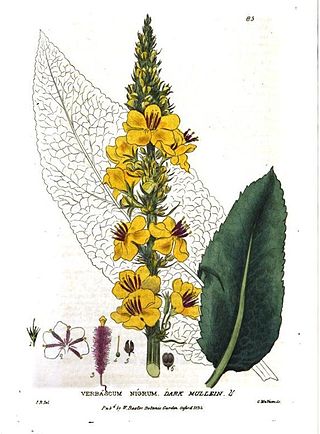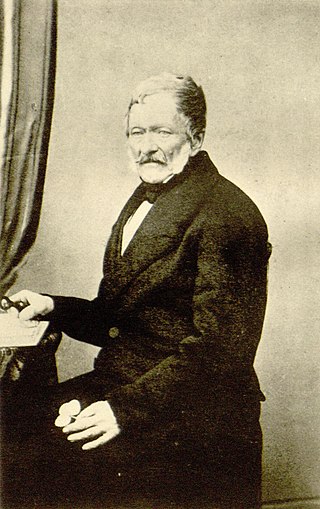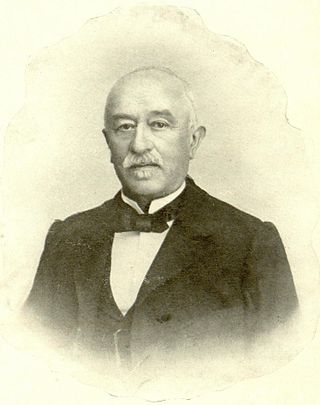Related Research Articles

Eugène Bourgeau (1813–1877) was a French naturalist. He was native of Brizon in the département of Haute-Savoie in France.
Christian Friedrich Ecklon was a Danish botanical collector and apothecary. Ecklon is especially known for being an avid collector and researcher of plants in South Africa.

Karl Wilhelm Gottlieb Leopold Fuckel was a German botanist who worked largely on fungi.

William Baxter ALS, FHS, was a British botanist, author of British Phaenogamous Botany and appointed curator of the Oxford Botanic Garden in 1813. From 1828 to 1828 he issed the exsiccata series Stirpes cryptogamae Oxonienses, or dried specimens of cryptogamous plants collected in the vicinity of Oxford. With Philip Burnard Ayres he distributed another exsiccata under the title Flora Thamnensis.
Philip Burnard Ayres (1813–1863) was a British physician, botanist and plant collector. He was born at Thame in Oxfordshire on 12 December 1813. He initially began to collect plants in his native United Kingdom and also in France. Between 1841 and 1845 he issued three exsiccata-like series, among them Mycologia Britannica or specimens of British fungi and with William Baxter another exsiccata under the title Flora Thamnensis. In 1856 Ayres was appointed by Queen Victoria to superintendency of quarantine on Flat Island, Mauritius under governor Robert Townsend Farquhar. Ayres is particularly well known for his extensive plant collections made while in this position. He is also credited for finding the first sub fossil remains of the dodo in 1860. From 1856 to 1863 he traveled through Madagascar, the Seychelles, and the Mascarenes to develop this rich collection of Indian Ocean plant specimens. These specimens are now in the herbaria collections of the Natural History Museum, London, the Royal Botanic Garden Edinburgh, the Royal Botanic Gardens, Kew, the Missouri Botanical Garden and the Muséum National d'Histoire Naturelle, Paris. In addition to collecting, Ayres catalogued and sketched the plants in the wild, as was common among nineteenth century naturalists. He also planned to write a book about the flora of Mauritius, but he died from relapsing fever in his home in Port Louis on 30 April 1863 before the flora could be accomplished. Ayres' wife Harriet collected his written records and bequeathed them to the Royal Botanic Gardens, Kew.
Friedrich Wilhelm Schultz was a German pharmacist and botanist who was a native of Zweibrücken.
Nicolas Charles Seringe was a French physician and botanist born in Longjumeau.

Jean Baptiste Henri Joseph Desmazières was a merchant of Lille and an amateur mycologist. He was the editor of the scientific journals "Annales des sciences naturelles" and the "Bulletin de la société des sciences de Lille".

Jean-Maurice Casimir Arvet-Touvet (1841–1913) was a French botanist born in Gières.
Marie Clément Gaston Gautier was a French botanist and agriculturalist.
Otto Christian Blandow was a German apothecary and botanist, specializing in the field of bryology.
Alphonse Maille was a French botanist.
Henri L. Sudre was a French botanist.

Frank Shipley Collins (1848–1920) was an American botanist and algologist specializing in the study of marine algae. He was a pioneer in the study of the distribution of algae on the Atlantic seaboard and Bermudas and was the leading American algologist of his time. He wrote The Green Algae of North America and Working Key to the Genera of North American Algae. Several species bear his name in his honor, including Collinsiella tuberculata, and Phaeosaccion collinsii.
Anna Vickers was a marine algologist and plant collector known principally for her work on algae of the Antilles and the Canary Islands.

John Michael Holzinger was a German-born American bryologist, expert on the bryoflora of Colorado, and third president of the Sullivant Moss Society.
Mary Wyatt (1789–1871) was a British botanist, phycologist and retailer from Torquay, Devon. She was the compiler of the respected Algae Danmonienses - a collection, i.e. exsiccata, of seaweeds to which William Henry Harvey later considered his Manual of the British Algae (1841) a 'companion' work. Wyatt helped to fuel the Victorian 'seaweed craze' for collecting. The tongue twister 'She Sells Seashells on the Sea Shore' was possibly inspired by Wyatt and her close companion Amelia Griffiths, with whom she collected seaweed and sea shells in Devon.

Exsiccata is a work with "published, uniform, numbered set[s] of preserved specimens distributed with printed labels". Typically, exsiccatae are numbered collections of dried herbarium specimens or preserved biological samples published in several duplicate sets with a common theme or title, such as Lichenes Helvetici. Exsiccatae are regarded as scientific contributions of the editor(s) with characteristics from the library world and features from the herbarium world. Exsiccatae works represent a special method of scholarly communication. The text in the printed matters/published booklets is basically a list of labels (schedae) with information on each single numbered exsiccatal unit. Extensions of the concept occur.
IndExs – Index of Exsiccatae is an online biological database that plays a pivotal role in documenting more than 2,200 historical and ongoing series of exsiccatae and exsiccata-like works. Managed by the Botanische Staatssammlung München in München, IndExs serves as a comprehensive data repository for these series, providing detailed titles with information on the more than 1,300 editors, bibliographic information, exsiccatal numbers, publication timespans, ranges, information on preceding and superseding series and publishers. Exsiccatae, organised series of biological specimens distributed among biological collections, are essential resources found in major herbaria worldwide. Open access to the general information on exsiccatae facilitates global scientific engagement and research.
John Bohler was an English botanist.
References
- ↑ Published: 1825. Algarum Fasciculi; or A Collection of British Sea-weeds, Carefully Dried and Preserved, and correctly named. University Press, Dublin. Purchased 1991 by Ulster Museum specimens catalogued: F8968 - F9145.
- ↑ William Henry Harvey (1857) Synopsis of British Seaweeds, pp103 Lovell Reeve, London. Link Retrieved 3 May 2010
- ↑ "Algarum fasciculi, or, a collection of British seaweeds, carefully dried and preserved, and correctly named after Dr. Harvey's "Phycologia Britannica", with a description of each plant, time of appearance, locality, etc.: IndExs ExsiccataID=286049536". IndExs – Index of Exsiccatae. Botanische Staatssammlung München. Retrieved 18 July 2024.
- ↑ Triebel, D. & Scholz, P. 2001–2024 IndExs – Index of Exsiccatae. Botanische Staatssammlung München: http://indexs.botanischestaatssammlung.de. – München, Germany.
- ↑ International Plant Names Index. Cocks.